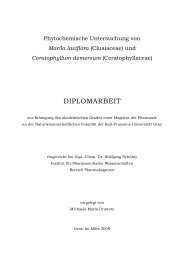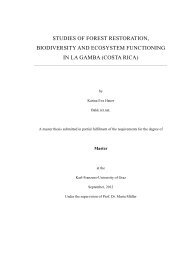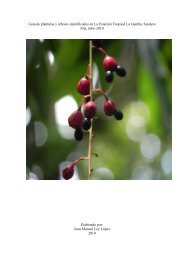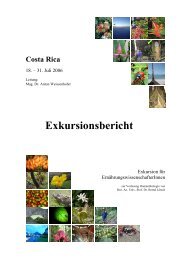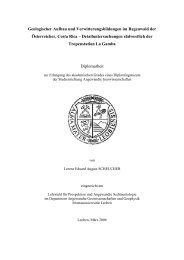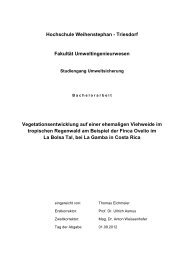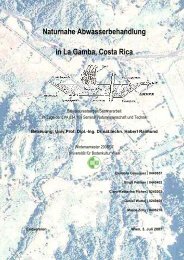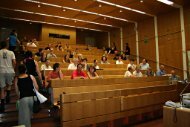Leaf colour patterns, vegetative and sexual reproduction of Episcia ...
Leaf colour patterns, vegetative and sexual reproduction of Episcia ...
Leaf colour patterns, vegetative and sexual reproduction of Episcia ...
You also want an ePaper? Increase the reach of your titles
YUMPU automatically turns print PDFs into web optimized ePapers that Google loves.
darker morphs. The results can, however, not be interpreted ins<strong>of</strong>ar as that the varied morphs are<br />
some kind <strong>of</strong> adaption for different light conditions. Thereto the focus <strong>of</strong> this investigation was<br />
not enough directed towards the differences among the varied morphs. These experiments can<br />
only be regarded as preliminary investigation. While gathering the presented data, the way <strong>of</strong><br />
proceeding seemed adequate. Unfortunately, the intervals <strong>of</strong> light energy measurements were set<br />
too coarse-meshed. The sun irradiation on a plant has to be measured continuously over the<br />
course <strong>of</strong> several days to ascertain the duration <strong>and</strong> incidence <strong>of</strong> sun spots. Only by that, the<br />
theory <strong>of</strong> Lee (2002) <strong>and</strong> Gould et al (1995) concerning the protective function <strong>of</strong> the<br />
anthocyanins against short-term heightened sun irradiation can be assessed. Special attention on<br />
the different morphs must be paid in this process.<br />
Colour Change in Correlation with Change in Habitats<br />
The influence <strong>of</strong> UV-radiation on the leaf <strong>colour</strong>ation is known <strong>and</strong> was already subject <strong>of</strong><br />
many investigations (Br<strong>and</strong>t et al. 1995, Mancinelli 1985, Wellmann et al. 1991). H<strong>of</strong>fman (1999)<br />
detected changes in leaf <strong>and</strong> flower <strong>colour</strong>ation <strong>of</strong> different species caused by UV-radiation. On<br />
the contrary, she did not found any shifts in <strong>colour</strong>, when the UV-wavelengths <strong>of</strong> the incoming<br />
light were blocked.<br />
The enhancement <strong>of</strong> anthocyanins within a leaf as a protective mechanism was already <strong>of</strong>ten<br />
observed <strong>and</strong> investigated (Bormann <strong>and</strong> Teramura 1993, Teramura 1983, Tevini <strong>and</strong> Teramura<br />
1989, Wellmann et al. 1991). The following experiment was conducted to clarify how <strong>Episcia</strong><br />
lilacina answers to enhanced solar radiation. For <strong>Episcia</strong> lilacina grows mainly on the shady forest<br />
ground, the plant is not used to prolonged sunny periods. What happens if the plants <strong>of</strong> <strong>Episcia</strong><br />
lilacina were transplanted to a sunnier location? Do they answer to an enhanced sun exposure?<br />
Do plants with dark red leaves differ in their reaction from plants with bright green leaves?<br />
Materials <strong>and</strong> Methods: Plants with bright green leaves <strong>and</strong> without visible anthocyanin<br />
concentration as well as plants with dark red leaves <strong>and</strong> intermediate stages were selected. A<br />
sunny <strong>and</strong> a shady place were chosen to conduct this experiment. Before starting, all plants were<br />
photographed to enable a comparison <strong>of</strong> the leaf <strong>colour</strong>ation afterwards. For the shady location<br />
seven plants were transferred from the rain forest to the main building <strong>of</strong> the biological station<br />
La Gamba. There, a maximum <strong>of</strong> 6 Lux <strong>of</strong> light intensity could be measured. The same was done<br />
with the plants, which were transferred to a sunny location. The search for a suitable sunny<br />
location turned out to be difficult. At first all plants were transplanted in a plastic bag (as a plant<br />
pot) <strong>and</strong> placed near the main building on a lawn, where the sun was shining almost all day long.<br />
38



